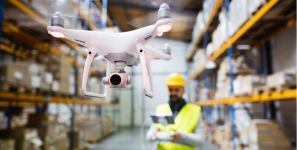Enter the Exosuit: How Exoskeletons Are Providing Clear ROI in Supply Chain Operations
Do more with less. It’s a harsh reality within the supply chain labor force, as companies are struggling to recruit and retain material handlers and other front-line staff. It’s not a new issue, but one that’s been exasperated due to increasing demands and a changing workforce. The responsibility of delivering goods and services in a shorter amount of time lands heaviest on warehouse workers who serve as the heart of operational efficiency. So how can executives ensure that the literal working hands of their company stay healthy and perform at their best? Part of the answer may lay in a singular solution, which can have an impact on a billion-dollar problem.
Every year, overexertion from handling objects costs companies more than $12 billion. It’s the number one cause of work-related injuries in warehousing and logistics, which is more than twice the rate of any other cause. Musculoskeletal injuries hit warehouse workers hardest and back pain has been noted as the leading cause of disability worldwide. While automation and robotics are offering relief for some workers, it is apparent that many tasks are going to be best performed by humans for a long time to come. And many of those same automation projects meant to make the warehouse more efficient actually increase the load on the remaining human staff. Many autonomous-mobile-robot programs, for instance, will make a warehouse more efficient, but dramatically increase the pick rate for workers, meaning they are bending and lifting even more products every hour than before.
Thankfully, there is a solution that started coming to market a few years ago that is starting to see wider adoption, one that improves both worker well-being and productivity: exoskeletons. In particular, soft exosuits, which are textile-based versions of exoskeletons, are seeing high user acceptance rates and have been shown to not only reduce back injury risk and compression force on spinal discs, but reduce fatigue – which is of critical importance to warehouse workers who are constantly lifting and transporting goods throughout the facility.
That reduction in fatigue was expected to have a direct impact on productivity, and now there is evidence to support that assumption. HeroWear recently conducted a study with an international premium grocery retailer tracking the number of cases picked per hour for their distribution center workers while wearing exosuits. The study analyzed data from a 9-week period: 4 weeks of baseline, 1 week of training, and 4 weeks where workers were given a soft exosuit to wear while picking orders. The conclusion of the study: productivity went up by more than 8% (every quartile from top performers to the bottom saw improvement in productivity) and worker-reported discomfort from performing those duties went down by 30%. Moreover, 81% of the workers voluntarily said they were willing to continue wearing the soft exosuits after the study was completed. That level of acceptance for a new piece of safety gear is well above average.
That last data point is a crucial one when examining worker retention. Worker turnover is a massive problem in supply chain businesses. Attrition is especially high in the first 30-90 days among warehouse staff. It is leading many executives to ask themselves, “Are we providing solutions that are aligned with our workers’ needs and helping them adapt to physically demanding jobs so they can do their jobs effectively?” If a company is offering resources that aren’t well-received or seem tone deaf, it’s a waste of time and money and can negatively impact the culture. Solutions need to allow employees to complete their tasks seamlessly and studies have shown soft exosuits can do that.
But while employee health is a goal we can all agree on, ultimately when considering any change to an operation, executives are evaluating against one major variable: return on investment; what’s the value of a product or service to a company and will it eventually pay for itself? Part of the HeroWear study involved evaluating the expected ROI of the project using industry average personnel costs, and the results were strong: a payback period of less than 6 months and potential ROI of 13x over 5 years. That analysis does not include potential savings on medical cost thanks to an expected reduction in injuries, or the potential savings from recruiting and retention boosts thanks to improving worker well-being. The potential benefits of an exosuit program reach throughout Operations, Safety, and HR/Retention departments.
Soft exosuits are an exciting solution for companies looking to solve evolving labor challenges. By improving retention through addressing worker well-being while at the same time improving productivity, teams can truly work the problem from both ends.





Leave a Reply